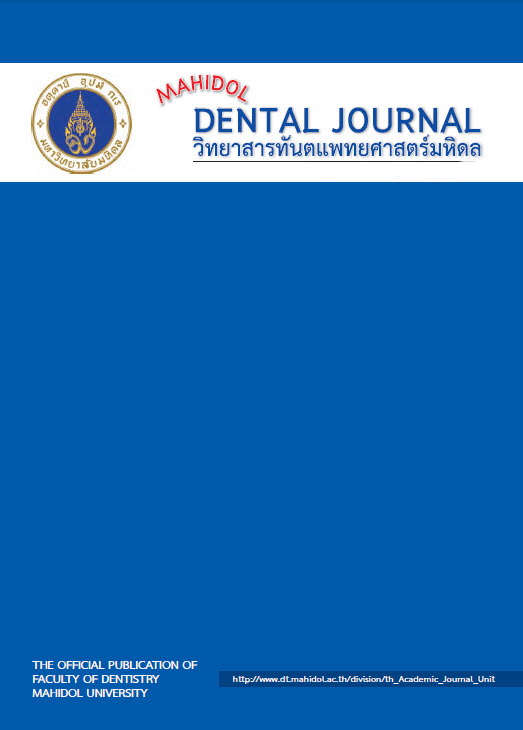Effect of three repairing materials on the flexural strength of repaired heat-cured acrylic resin denture base material
Main Article Content
Abstract
Objectives: To investigate the effect of different materials and repairing techniques on the flexural strength of heat-cured acrylic denture bases.
Materials and methods: Seventy-five specimens of Probase Hot with rectangular shape (63x10x3mm.) were processed according to manufacturer’s instruction. Only three specimens were intact, the remaining was further divided into two main groups (n=36) by repairing using small gap (2/10mm) and big gap (9/17mm). In each group, three brands of repairing materials Kooliner (GC America Inc), Tokuyama Rebase Fast II (Tokuyama Co., Ltd, Tokyo, Japan), and Unifast Trad Pink (GC America Inc) were used to fill in the gap (n=12). Prior to testing, all specimens were immersed in distilled water at 37ºC for 43±2h. The flexural strength of intact and repaired specimens was calculated using three-point bending test with Shimadzu Universal Testing Machine. Two-way ANOVA was used to analyze the data at α=0.05. Simple effect test was also used to identify a significant difference of pairs.
Results: There was an effect of materials and repairing techniques on the flexural strength of acrylic denture bases. Unifast Trad Pink showed the highest repair strength among all materials, while repair using larger gap displayed higher repair strength than that with smaller gap. However, there was no significant difference in term of repairing technique in the group repaired with Tokuyama Rebase Fast II. The flexural strength of all repaired specimens was lower than that of intact specimens.
Article Details
References
2.Bergman B., & Carlsson G.E. Clinical long-term study of complete denture wearers.
J Prosthet Dent 1985; 53: 56-61.
3.Vermeulen A.H., Keltjens H.M., van't Hof M.A., & Kayser A.F. Ten-year evaluation of removable partial dentures: survival rates based on retreatment, not wearing and replacement. J Prosthet Dent 1996; 76: 267-72.
4.Beyli M.S., & von Fraunhofer J.A. An analysis of causes of fracture of acrylic resin dentures. J Prosthet Dent 1981; 46: 238-41.
5.Schneider R.L. Diagnosing functional complete denture fractures. J Prosthet Dent 1985; 54: 809-14.
6.Arima T., Murata H., & Hamada T. Analysis of composition and structure of hard autopolymerizing reline resins. J Oral Rehabil 1996; 23: 346-52.
7.Bunch J., Johnson G.H., & Brudvik J.S. Evaluation of hard direct reline resins. J Prosthet Dent 1987; 57: 512-9.
8.Wyatt C.C., Harrop T.J., & MacEntee M.I. A comparison of physical characteristics of six hard denture reline materials. J Prosthet Dent 1986; 55: 343-6.
9.Arena C.A., Evans D.B., & Hilton T.J. A comparison of bond strengths among chairside hard reline materials. J Prosthet Dent 1993; 70: 126-31.
10.Leles C.R., Machado A.L., Vergani C.E., Giampaolo E.T., & Pavarina A.C. Bonding strength between a hard chairside reline resin and a denture base material as influenced by surface treatment. J Oral Rehabil 2001; 28: 1153-7.
11.Arima T., Nikawa H., Hamada T., & Harsini. Composition and effect of denture base resin surface primers for reline acrylic resins. J Prosthet Dent 1996; 75: 457-62.
12.Mutluay M.M., & Ruyter I.E. Evaluation of adhesion of chairside hard relining materials to denture base polymers. J Prosthet Dent 2005; 94: 445-52.
13. Leong A., & Grant A.A. The transverse strength of repairs in polymethyl methacrylate. Aust Dent J 1971; 16: 232-4.
14.Beyli M.S., & von Fraunhofer J.A. Repair of fractured acrylic resin. J Prosthet Dent
1980; 44: 497-503.
15.Rached R.N., Powers J.M., & Del Bel Cury A.A. Repair strength of autopolymerizing, microwave, and conventional heat-polymerized acrylic resins. J Prosthet Dent 2004;
92: 79-82.
16.Lin C.T., Lee S.Y., Tsai T.Y., Dong D.R., & Shih Y.H. Degradation of repaired denture base materials in simulated oral fluid. J Oral Rehabil 2000; 27: 190-8.
17. Dar-Odeh N.S., Harrison A., & Abu-Hammad O. An evaluation of self-cured and visible light-cured denture base materials when used as a denture base repair material. J Oral Rehabil 1997; 24: 755-60.
18. Vallittu P.K., Ruyter I.E., & Nat R. The swelling phenomenon of acrylic resin polymer teeth at the interface with denture base polymers. J Prosthet Dent 1997; 78: 194-9.
19. Polyzois G.L., Tarantili P.A., Frangou M.J., & Andreopoulos A.G. Fracture force, deflection at fracture, and toughness of repaired denture resin subjected to microwave polymerization or reinforced with wire or glass fiber. J Prosthet Dent 2001; 86: 613-9.
20. Rached R.N., & Del-Bel Cury A.A. Heat-cured acrylic resin repaired with microwave-cured one: bond strength and surface texture. J Oral Rehabil 2001; 28: 370-5.
21.Vallittu P.K. The effect of surface treatment of denture acrylic resin on the residual monomer content and its release into water. Acta Odontol Scand 1996; 54: 188-92.
22.Ward J.E., Moon P.C., Levine R.A., & Behrendt C.L. Effect of repair surface design, repair material, and processing method on the transverse strength of repaired acrylic denture resin. J Prosthet Dent 1992; 67: 815-20.
23.Berge M. Bending strength of intact and repaired denture base resins. Acta Odontol Scand 1983; 41: 187-91.
24.Ellakwa A.E., & El-Sheikh A.M. Effect of chemical disinfectants and repair materials on the transverse strength of repaired heat-polymerized acrylic resin. J Prosthodont 2006; 15: 300-5.
25.Vojdani M., Rezaei S., & Zareeian L. Effect of chemical surface treatments and repair material on transverse strength of repaired acrylic denture resin. Indian J Dent Res 2008; 19: 2-5.
26.Urban V.M., Machado A.L., Vergani C.E., et al. Degree of conversion and molecular weight of one denture base and three reline resins submitted to post-polymerization treatments. Materials Research 2007; 10: 191-97.
27.Blagojevic V., & Murphy V.M. Microwave polymerization of denture base materials.
A comparative study. J Oral Rehabil 1999; 26: 804-8.
28.Lee S.Y., Lai Y.L., & Hsu T.S. Influence of polymerization conditions on monomer elution and microhardness of autopolymerized polymethyl methacrylate resin. Eur J Oral Sci 2002; 110: 179-83.
29.Thean H.P., Chew C.L., Goh K.I., & Norman R.D. An evaluation of bond strengths of denture repair resins by a torsional method. Aust Dent J 1998; 43: 5-8.
30.Thunyakitpisal N., Thunyakitpisal P., & Wiwatwarapan C. The effect of chemical surface treatments on the flexural strength of repaired acrylic denture base resin. J Prosthodont
2011; 20: 195-9.


